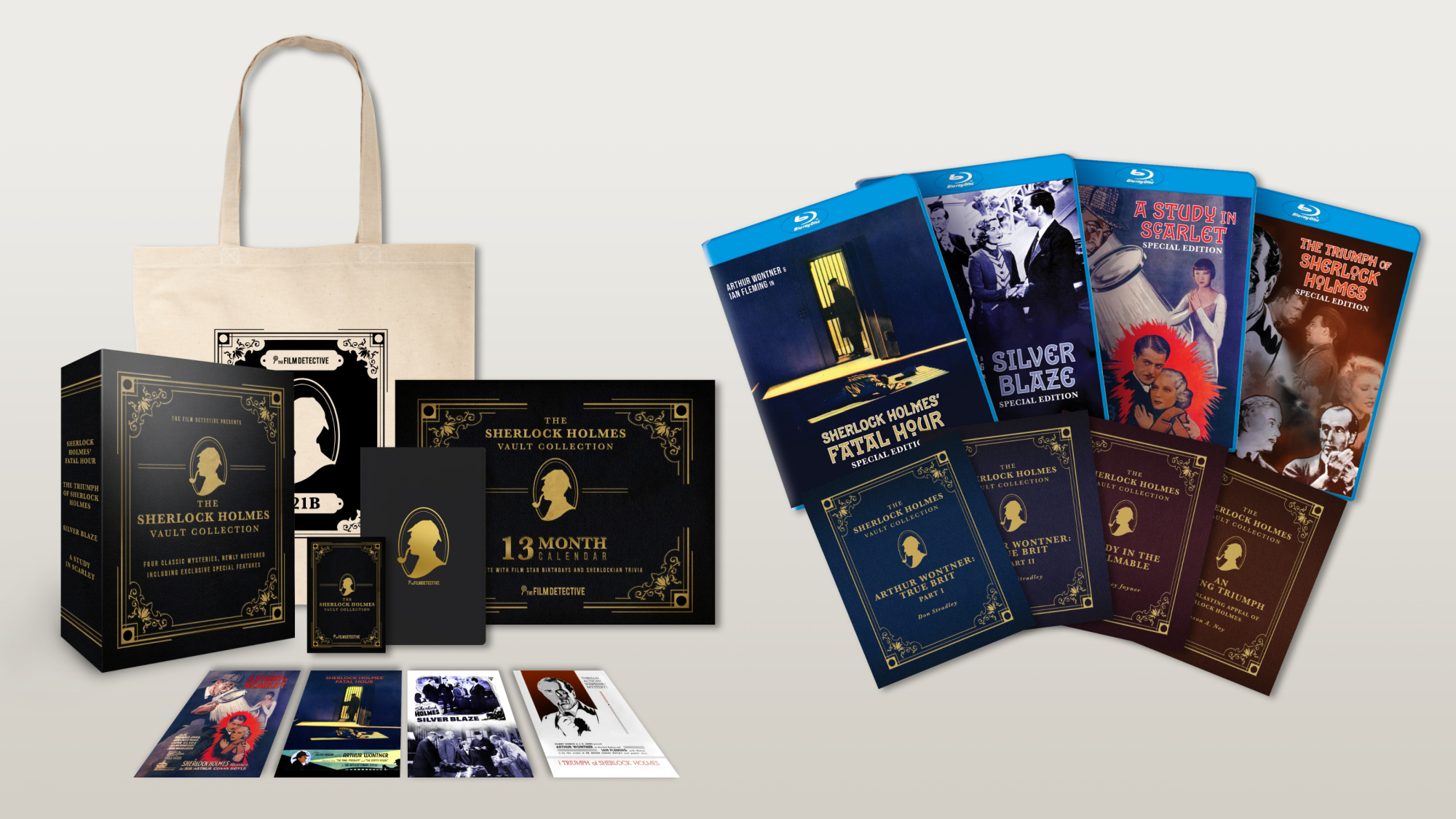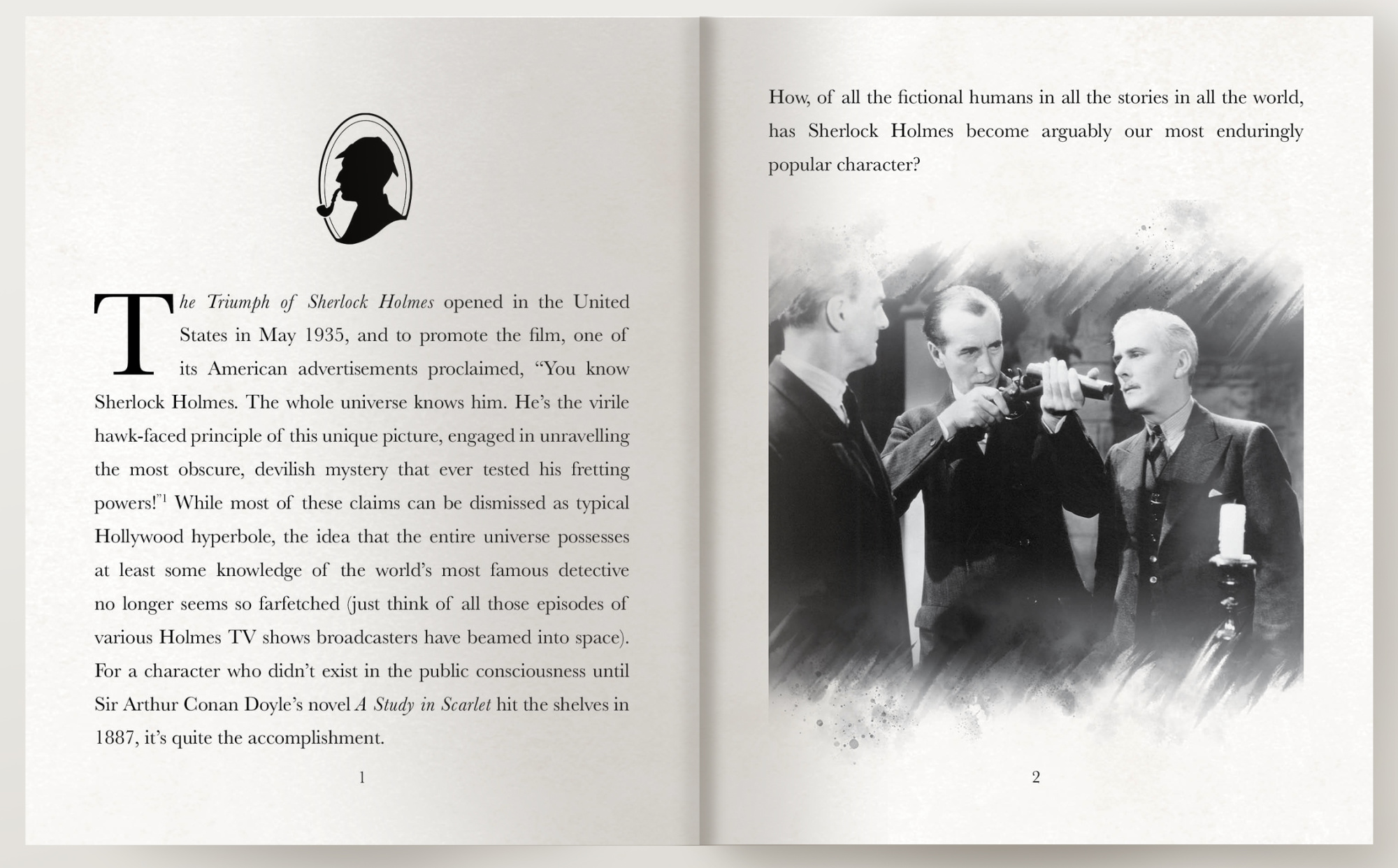What about the new four-disc Sherlock Holmes Vault Collection of 1930s films?
I would have started by saying, “Elementary, my dear Watson.” But that iconic phrase was never actually written by Holmes creator Sir Arthur Conan Doyle but an invention for the movies; it’s one of the many things I learned in the multiple entertaining and informative bonus features with this set about the clever lanky London detective.
Nonetheless, the expression is apt here, and is spoken in these movies from classic film restoration and streaming company The Film Detective (TFD), available as of Dec. 21 from Cinedigm (Blu-ray $59.95; Limited Edition Collector’s Box Set: $69.99 – a 13-month Sherlockian calendar with special anniversary dates and fun Holmes facts; a collector’s magnet, tote bag, notebook, and one-year subscription to TFD app. Three randomly-selected box sets also include an exclusive, limited-edition Sherlock Holmes custom pipe, courtesy of Peterson of Dublin.)
This is a must-own set for any fan of the fictional Sherlock Holmes, who is largely credited for introducing forensics into real-life crime investigations.
(Continue reading below the following photo…)

The four films included in the set are special editions of the little-seen first feature-length Sherlock Holmes movies (most are 70-75 minutes each; one is 84-minutes) that followed a few Sherlock Holmes shorts. All were produced in the early-to-mid 1930s just after Doyle’s death in 1930 and prior to those starring Basil Rathbone in the 1940s. Three are British productions produced by Julius Hagen at Twickenham Film Studios, including the first and last of the five-film series from 1931 – 1937 based on Doyle stories that starred prominent English stage actor Arthur Wonter as Holmes:
- “Sherlock Holmes’ Fatal Hour” (1931; released in England as “The Sleeping Cardinal”);

- “The Triumph of Sherlock Homes” (1935);
- “Silver Blaze” (1937, released in the US in 1941 as “Murder at the Baskervilles”).
- The fourth film in the set is the American-made (California Tiffany Studios) and Fox Film distributed “A Study in Scarlett” (1933), starring Reginald Owen as Holmes in an original story by Robert Florey directed by Edwin L. Marin.
(Continue reading below the following photo…)

Of course these films are from the early days of filmmaking — just past the silent film days in first years of “talkies,” and they are clearly low-budget, so-called “B” pictures. Nonetheless, they are charming and compelling.
As fun as these movies are to see, especially in such remarkable quality, nearly as enjoyable is the biggest collection of bonus materials ever released by TFD. Among the most notable:
- “Elementary Cinema: The First Cinematic Adventures of Sherlock Holmes” from Ballyhoo Motion Pictures, a 26-minute documentary with “A Study in Scarlett” produced, directed, and edited by Daniel Griffith, written and produced by C. Courtney Joyner, and narrated by Mark Redfield, provides a comprehensive historical perspective on Doyle and the complex cinematic evolution of the Holmes movies, with a plethora of archival footage, as well as lots of tangential connections to high-profile people like Alfred Hitchcock.
- entertaining and informative feature-length audio commentaries on each film: Jennifer Churchill (“Fatal Hour”) – the pleasing voice with trivia-filled commentary also heard on TFD’s “The Fabulous Dorseys” provides more of the same here, including a note that the term fandom originated to describe followers of Doyle’s Sherlock Holmes (Holmes famously tired of writing about Holmes and tried to kill off the character many years before he even became a cinema star but fans pressured Doyle to keep Holmes alive); authors/screenwriters Peter Atkins and David Breckman (“A Study by Scarlett”); author and film historian Jason A. Ney (“The Triumph of Sherlock Homes”); and writers/producers Phoef Sutton and Mark Jordan Legan offer what sounds like a casual, freewheeling conversational episode of their Film Freaks podcast (“Silver Blaze”).
- A 1926 Mutt & Jeff detective agency animated short called “Slick Sleuths” with the “Study in Scarlett” disc, a historical delight, especially for those who may be familiar with the duo but have never seen their cartoons.
- an engaging well-produced radio broadcast recreation from Redfield Arts Audio, “Sherlock Holmes and the Blue Carbuncle,” which takes place at Christmastime in London (Holmes and others voiced by Mark Redfield).
- “A Black Sherlock Holmes” (April 1918) – from the American Film Institute Collection at the Library of Congress, the first production of the newly-reorganized Ebony Film Corp., a fascinatingly unusual 13-minute very damaged but still watchable silent film with musical accompaniment featuring the pipe-smoking “Knick Garter, the great detector and admirer of Sheeza” and “his assistant Rheuma Tism.” (An edited and cleaned-up second version of this short is called the “Cut” version but it actually runs longer at 14-min.)
- The Adventures of Sam Sherman (Part One on “Fatal Hour,” Part Two on “The Triumph of Sherlock Holmes”), 7 1/2-minute featurettes in which filmmaker and film history icon, Samuel M. Sherman provides interesting trivia about the era such as the term “quota quickies” that applied to movies made by studios to comply with government-mandated requirements for films to be produced for international distribution featuring British cast and crew, and the fact that the audio recording studio of Twickenham Film Studios where these Holmes films were produced was later used by The Beatles.
- handsome 12-page essay booklets with each disc featuring appealing illustrations and still-frame images, one written by author/screenwriter C. Courtney Joyner (“A Study in Scarlett”), an enlightening and easy-to-understand explanation of the complex legal/copyright history of the very controversial story about the investigation of murders during the mid-19th century Mormon pilgrimage to Utah, with a “blistering portrait of Brigham Young.” Doyle sold the story for needed income, but while the subject itself created problems, there were also multiple royalties challenges as it was reprinted worldwide. This first of Doyle’s Holmes stories to be adapted to film was first a silent two-reeler in 1914. After visiting with Mormon officials in 1923, Doyle (and later his daughter) apologized for his characterization and edited future publications of the story, and by the time Hollywood adapted it for the first time in the 1933 version included in this set, only the title remained with a completely new story.
Other essays are by Jason A. Ney (“The Triumph of Sherlock Holmes,” in which he notes that productions about Holmes that already lead most fictional characters, will likely increase next year when the last of Doyle’s Holmes stories goes into public domain); author Don Stradley (“Fatal Hour” and “Silver Blaze,” a two-part essay profiling Holmes actor Arthur Wontner).

There are also many other newly-restored Sherlockian shorts, including Sherlock Holmes Baffled (1900), Sure Luck Holmes (1928), Cousins of Sherlocko (1913), and The Copper Beeches (1912).
Other special features include: the eighth half-hour episode “The Case of the Blind Man’s Bluff” from the 1954-55 syndicated Sherlock Homes TV series starring Ronald Howard as Holmes and Howard Marion-Crawford as Dr. Watson; and original film posters replicated as postcards.
— By Scott Hettrick
